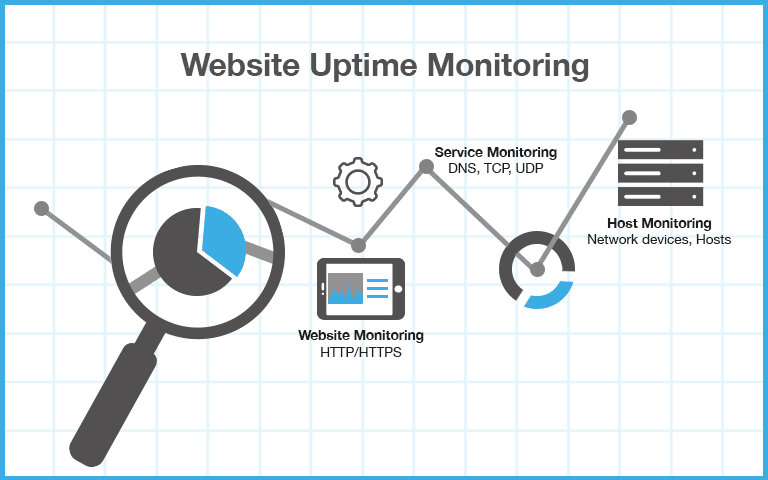
A website monitoring service, or domain monitoring service, can be an absolute lifesaver.
Along with regular, non-local backups, these are the two best insurance policies you’ll ever have.
For context: one of the worst experiences I’ve had running a business happened when I launched a new offer, and found I had zero sales after nearly 12 hours.
Great offer, great price, great value, lots of promotion.
So what was the problem?
None, unless you actually tried to purchase, at which point, well, nothing happened.
Or more accurately, your browser said something to the effect of “Website Not Found”.
Whether it’s an offer, blog post, announcement, or anything else online; if it becomes ‘unavailable’, you’re hosed.
Finding out that something you’ve invested a lot of time, money, and effort in has crashed, disappeared, or is otherwise unavailable just sucks. There’s really no other word for it.
Of course, stuff happens.
But in my experience, nearly every time I’ve seen or experienced something like that, it’s been entirely avoidable.
Some of the worst experiences I’ve had like this have been when a site went down, and I didn’t find out about it until some time later – typically after I’d just poured money into a paid traffic campaign to the site, or while running a promotion that should have generated a lot of revenue, or some other equally crucial time.
Fortunately, that’s largely a thing of the past.
Today, all of my sites are monitored externally, and I can’t tell you how many times that’s saved our bacon!
WEBSITE MONITORING SERVICES

Website monitoring is really a generic umbrella term for a range of tracking, testing, and reporting services.
At its most basic, website monitoring is really “uptime” monitoring, and it’s just what it sounds like: checking to see if your site is “up”.
To do this, a monitoring company or application will ping the website’s URL on a repeating schedule to see if it’s accessible.
If all is well, nothing will happen. But if your site cannot be accessed, a message will be generated and emailed or texted to you.
Beyond this basic uptime monitoring, there is a range of security, performance, and analytics data that can be monitored and reported on to help you improve rankings, site speed, user experience, and overall reliability.
There are dozens and dozens of companies – and apps – that can monitor your websites, with services ranging from basic daily uptime monitoring, to sophisticated tracking and real-time reporting.
As you might imagine, you can pay quite a bit for these services, depending on the depth & breadth of the monitoring, the frequency (once daily, every hour, every 5 minutes, or real-time) of the checks, and the type of alarm and speed with which you’re notified.
Fortunately, there are a number of free website monitoring & alert services available that can keep this from ever being a “lesson you never wanted to learn”.
Each has various features and strengths, with basic daily uptime monitoring as the minimum baseline.
In no particular order, here are 10 free monitoring services:
(NOTE: These listings were validated as of Q4, 2022)
Uptrends => https://www.uptrends.com/free-website-monitoring
Uptime Robot => https://www.uptimerobot.com/
Monastic => http://montastic.com/
Awakish => https://www.awakish.com/
Basic State => http://basicstate.com/
Uptime Dog => http://www.uptimedog.com/
Root Internet => http://monitor.rootinternet.co.uk/en…monitoring.php
Site Uptime => http://siteuptime.com/
Service Uptime => http://www.serviceuptime.com/
Status Cake => https://www.statuscake.com/
Additional Free Monitoring Tools
Uptrends => https://www.uptrends.com/tools
As you might imagine, some of the free monitoring services are somewhat limited, but you may be surprised by what some of them offer for free.
Some offer relatively complete free monitoring, and many offer additional free services as well.
Do It. Now.

Anyone who has been online – or in IT – for a significant length of time has at least one horror story, often a costly one, and sometimes catastrophic, that ends with something like “… if only I’d made a backup like I knew I should have!”
Think of website monitoring as the flip-side of the same coin.
(I should mention, this isn’t in place of non-local backups, and in fact those are generally even more important. If you don’t have a regular, preferably automated backup routine in place, Stop – do not pass go, and do THAT right away, right after you do what follows on the next line…)
At the very least, stop what you’re doing, sign up, and set up monitoring for your critical websites and domains.
I promise you that you won’t be sorry!

